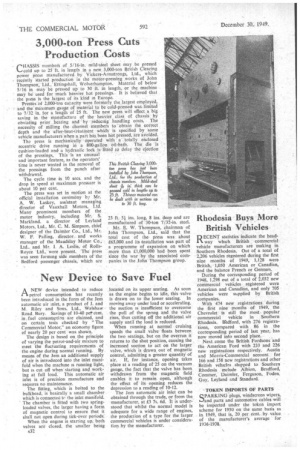3,000-ton Press Cuts Production Costs
Page 34

If you've noticed an error in this article please click here to report it so we can fix it.
CHASS1S member's of 5/16-in, mild-steel sheet may be pressed ‘,...cold up to 25 ft in length M a new 3,000-ton British Clearing power press manufactured by Vickers-Armstrongs, Ltd., which recently started production in the Motor-pressing .works of John Thompson; Lid; Ettingshall, Wolverhampton. Material of below 5/16 in -may be pressed up to 30 ft. in length, or the machine may be' 'used for mach heavier hot pressings. It is believed that
the press is the largest of its kind in Europe.
Presses-Of 2,000-ton cailacity Were formerly the largest employed, and the-maximum gauge of material to be cold-presSed was limited to 7/32 -in. for a length of 25 ft. The new press will effect a big saving in the manufacture of the • heavier class of Chassis by obviating prior heating and by reducing handling costs: The necessity of Milling the channel members to -obtain the correct depth and the after-heat-treatment whiChis specified by some vehicle manufacturers when a part has been hot pressed, are avoided.
Thz press is mechanically operated with a totally enclosed eccentric drive running in a 800-.gallon oil-bath. The, die is cushion-loaded and a hydraulic lock is fitted 16 delay the ejection of the pressings. This is an unusual and important feature, as the operators'
time is never wasted in the removal of This British Clearing 3,000 the pressings from the punch after Ion press has just been withdrawal. installed by John Thompson, The cycle time is 10 secs. and the Ltd.; for the production of drop in speed at maximum pressure is chassis members. Mild-steel
about 10 per cent The press was set in motion at the official installation ceremony by Mr. A. W. Laskey, assistant managing director of Vauxhall Motors, Ltd. Many prominent members of the motor industry, including Mr. S. Markland. a director of Leyland Motors, Ltd., Mr. C. M. Simpson, chief designer of the Daimler Co., Ltd., Mr. W. F. Pailing, director, and works manager of the Maudslay Motor Co., Ltd.. and Mr. I. A. Leslie, of RollsRoyce Ltd., were present. The press was seen forming side members of the Bedford passenger chassis, which are 23 ft. 51 ins. long, 8 ins. deep and are manufactured of 30-ton 7/32-in. steel.
Mr. E. W. Thompson, chairman of John Thompson, Ltd., said that the total cost of the press was about £65,000 and its installation was part of a programme of expansion on which more than £1,000,000 had been spent since the war by the associated companies in the John Thompson group.
Rhodesia Buys_ More British Vehicles
D ECENT statistics indicate the headJA way which British commercial vehicle manufacturers are making in Southern Rhodesia. Out of a total of 2,206 vehicles registered during the first nine months of 1949, 1,128 were -British, 1,050 American or Canadian, and the balance French or German.
During the corresponding period of 1948, 1,298 out of a total of 2,032 new commercial vehicles registered were American and Canadian, and only 705 vehicles were supplied by British companies.
With 474 new registrations during the first nine months of 1949. the Chevrolet is still the most • popular commercial vehicle in Southern Rhodesia. Bedford, with 276 registrations, compared with 86 in the corresponding period of last year, has now moved into second place.
Next come the British Fordsons and the American Ford with 233 and 226 new registrations respectively. Austin and Morris-Commercial account for 166 and 158 new registrations and other British vehicles shipped to Southern Rhodesia include Albion, Bradford, Commer, Daimler, Ferguson, Foden. Guy, Leyland and Standard.
TOKEN IMPORTS OF PARTS
SPARKING plugs, windscreen wipers, and parts and automotive cables will be imported under the token import scheme for 1950 on the same basis as in 1949, that is, 20 per cent. by value of the manufacturer's average for 1936-1938.




















































































